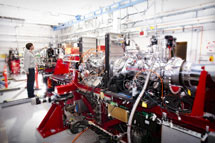
Handy Links
SLAC News Center
SLAC Today
- Subscribe
- Archives: Feb 2006-May 20, 2011
- Archives: May 23, 2011 and later
- Submit Feedback or Story Ideas
- About SLAC Today
SLAC News
Lab News
- Interactions
- Lightsources.org
- ILC NewsLine
- Int'l Science Grid This Week
- Fermilab Today
- Berkeley Lab News
- @brookhaven TODAY
- DOE Pulse
- CERN Courier
- DESY inForm
- US / LHC
SLAC Links
- Emergency
- Safety
- Policy Repository
- Site Entry Form

- Site Maps
- M & O Review
- Computing Status & Calendar
- SLAC Colloquium
- SLACspeak
- SLACspace
- SLAC Logo
- Café Menu
- Flea Market
- Web E-mail
- Marguerite Shuttle
- Discount Commuter Passes
-
Award Reporting Form
- SPIRES
- SciDoc
- Activity Groups
- Library
Stanford
Around the Bay
LCLS CXI Instrument Receives First X-rays
X-rays entered the Linac Coherent Light Source's Far Experimental Hall for the first time Saturday, as part of commissioning for the Coherent X-ray Imaging instrument. The team of instrument scientists, accompanied by many staff members of the Photon Controls and Data Systems groups, other LCLS staff and a few onlookers welcomed X-rays to CXI shortly before 2:30 p.m. This was followed by several hours of SLAC Radiation Physics Department surveys and validation of the instrument hutch.
CXI is the fourth instrument to come online at the LCLS, although it occupies the fifth experimental hutch along the beamline—the second of three in the Far Hall. Along with the X-ray Pump Probe instrument, the CXI is one of two LCLS instruments that will work with high-energy hard X-rays.
Ultimately, researchers hope to use these hard X-rays at CXI to image single biological molecules that cannot be imaged with a synchrotron lightsource. Synchrotron beams require molecules to be crystallized, meaning billions of them are arranged in a repeating pattern. Researchers can analyze X-rays that scatter off of these three-dimensional structures to determine the shape of the individual molecules. Some biological molecules, however, cannot be crystallized, and single molecules would be destroyed in the intense, constant beam of a synchrotron before a clear image could be generated.
The short, single pulses at LCLS and the unique capabilities of the CXI instrument help to solve this problem. Un-crystallized, individual molecules can sit on a fixed target placed in the beam path within the CXI sample chamber or enter the path of the beam via a particle injector. The powerful X-ray pulse will destroy the sample, but, in principle, not before its scattered photons reach the detector and deliver information about the intact molecule.
"CXI is a flexible instrument,” said CXI Instrument Scientist Sebastien Boutet. "It was designed for single-molecule imaging but it can do a lot of other things, even things we haven’t thought about yet.”
Boutet and the CXI team have spent the last few weeks preparing the 20-meter instrument to receive its first X-rays. They had to make, install and test the vacuum chambers that will hold experimental samples, set up the controls that run the machine, then get each component of the instrument, including the detectors, under vacuum. The vacuum environment helps to minimize air scattering of the X-rays, which could overshadow the signal from the tiny sample molecules, Boutet explained.
With X-rays now available in the hutch, the CXI team will first look at the size and shape of the beam and test their beam diagnostic equipment. During the remainder of CXI commissioning, which extends through spring 2011, they will test more complicated components, including the focusing optics, sample chambers and detectors.
"We certainly have plenty to keep us busy," Boutet said.
—Lauren Rugani
SLAC Today, December 13, 2010
